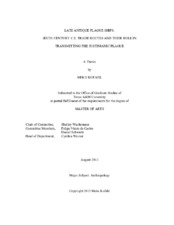| dc.description.abstract | The major European epidemic of bubonic plague in the sixth century C.E. – named for the ruling Byzantine emperor, Justinian – devastated the empire at the same time that outside pressures in the form of Goths, Vandals, Persians and others were also eroding the territory held by the Byzantines. While far less documentation survives the period between 550-750 C.E. than does for the periods before and after, we do have numerous references to specific plague outbreaks with which it is possible to reconstruct a transmission path and timeline.
The combination of geographical information systems (GIS) tools, literary references, modern archaeological finds and DNA analysis of excavated sixth-century C.E. graves creates an opportunity past researchers of this plague have not had for linking individual outbreaks. Synthesizing this data gives us a more detailed path of transmission than has previously been available and more clearly illustrates the relationships between various cities and countries through which the plague moved during the epidemic.
Although several authors have done outstanding work tracing the path of the plague through specific regions, no prior work has combined all known literary references to the Justinianic plague for the specific purpose of mapping its course. This thesis attempts to do just that by combining the plague outbreak information with trading data, evidence from shipwrecks, ancient road information, archaeological finds, and other materials to present a plausible transmission scenario.
This synthesis reveals, in many cases, a startlingly clear relationship between cities during phases of the epidemic. While epidemiological work has strongly suggested that waterborne transmission was required for the speed of the spread, it is evident when all available information is mapped. Holes in our information are similarly highlighted, and present opportunities for focused plague-related research and/or excavation.
This thesis presents a fresh look at old data, but also opens the door for new questions and lines of inquiry. | en |


